by Rick Rieder, Blackrock
Rick Rieder and Russ Brownback highlight the investment themes that they think will drive markets and dominate debate within the investment community over the next several months and beyond.
Over recent weeks, we have been vocal about five “big themes” for markets that will likely dominate the second half of 2019. These themes take stock of a collection of secular and cyclical factors that have combined to create an unprecedented macro backdrop. Specifically, over recent quarters excessively tight global monetary policy and contracting global liquidity have conspired with ongoing secular disinflationary forces and velocity-dampening trade friction such that while global real economy performance has been okay this year, it is far from optimal. Still, we think the market influence of these encumbrances is poised to abate over coming weeks and we are adjusting positioning accordingly.
Dearth of yield availability supports income-producing markets
Our first theme is quickly becoming common refrain; quite simply, there is not enough investment income available in the world today relative to the aging population that desperately needs it. As a case in point, nearly 30% of developed market (DM) global government bond debt is negative yielding today, while almost 80% of it yields less than 2%. Moreover, yields across credit sectors are similarly scarce, as issuance from traditional “yieldy” entities is plummeting due to dwindling global demand for traditional debt-financed corporate capital expenditure.
A similar decline in net new debt issuance is likely across less traditional sectors as well, including municipals, and commercial and residential mortgage backed securities. Simultaneously, downward pressure on interest rates is exacerbating the deficits associated with universally unfunded liabilities (pension funds, etc.) that are already suffering from this shortage of yield issuance. We believe that this technical influence is structural in nature and will therefore be firmly entrenched for the foreseeable future (see graph). Accordingly, we are endeavoring to sensibly purchase income and cash flow where possible, while steering clear of lower-quality assets, and being sensitive to the liquidity-premium in some assets today.
A growth conundrum haunts Europe
Our second theme pertains to the inefficiencies associated with the relative pricing across the European asset stack, system wide. In fact, the cost of European debt capital is unprecedentedly low, so much so that it is actually dampening the very velocity that its policy-induced pricing is meant to facilitate. At the same time, European equity capital is punitively expensive to use as a funding source, alongside of other structural headwinds that continue to dampen investors’ Euro-area growth expectations. All else equal, companies will invest in growth-enhancing initiatives if their expected return on assets exceeds their weighted-average cost of capital.
In contrast, the existing European capital stack paradigm is destroying the potential of that economic multiplier. Overall, there is minimal private sector willingness to fund riskier corporate investments via low, or zero, yielding corporate debt, which means that European companies must rely heavily on expensive equity capital, creating insurmountable hurdles to such investment. We maintain that Europe’s economic destiny lies in its policy makers’ hands, and that they should aggressively pursue initiatives that can quickly correct these anomalies and return the European private sector to a globally competitive stance.
The sun rises on synchronized global easing
Our third, and perhaps most important theme is the nascent dawn of a globally synchronized monetary policy easing cycle; one that markets have already begun to aggressively price in. The European Central Bank (ECB) looks set to take the lead with a resumption of asset purchases combined with further rate cuts. The Federal Reserve has signaled a near term rate cut, which we consider to be a move toward a less restrictive policy posture, rather than easing from an already accommodative stance.
And while resilience in U.S. economic growth may seem inconsistent with a Fed that’s cutting rates, the U.S. economy would be in a more optimal place with a lower funds rate that can enable other global central banks to provide accommodation where it is sorely needed. Chief among these are the many emerging market nations where oppressively tight monetary policy has been necessary for defense of local currencies that suddenly became vulnerable to acute downside risks last year as global liquidity contracted precariously. In fact, resumption of a coordinated global easing will likely provide a much-needed reboot of the global liquidity cycle that can then underpin continued positive market performance for both risk and rates in the back half of 2019.
Whither inflation?
Our fourth theme is inflation, or rather a lack thereof; a phenomenon that has evolved to the point in which it is a dominant macro influence. While the decline in inflation has moderated over recent months, it remains the case that there is little to no pricing power for most industries and companies. Omnipresent technological advances, particularly those used to add scale to labor productivity persist in squeezing costs across global supply chains and at the same time create advanced jobs with high wages. Specifically, the tangible addressable market for autonomous vehicles, artificial intelligence, Internet-of-Things, industrial software and robotics looks set to rise well into the trillions of dollars over the next five years and the number one driver of that is the maturation of 5G connectivity. This progression can result in persistent, steady growth and ongoing virtuous secular disinflation.
Use market volatility to carefully wade into emerging markets assets
Our final theme is to carefully embrace some select emerging markets (EM) assets that have been unjustly shunned over the past year, as part of a balanced portfolio, as restrictive local monetary policy and persistent trade frictions have constrained real-economy activity in these regions. More recently, performance has stumbled again in the wake of the continued escalation of the U.S./China trade conflict. Still, EM assets are often a sweet spot for coordinated global policy easing, and eventually EM central banks end up contributing to the DM easing effort, as velocity-induced inflows to these destinations eventually provide the requisite local currency strength to justify an easier policy posture, all else equal.
That supportive backdrop is accentuated by strong technical factors. Year-to-date EM inflows have mostly been centered on hard currency assets and the logical sequence is for incremental inflows to seek the higher yields still available in local currency expressions. Moreover, net new issuance is waning on a secular basis as EM countries transform their economies toward a larger services-sector orientation, like their DM counterparts. While we are sensitive to recent market volatility, idiosyncratic country-risk, added trade tensions/barriers, and the fact that some recent investment by those seeking out yield could all combine to create some near-term overhang, we do like opportunistically capturing yield here. However, we think it’s best done in the context of a balanced portfolio, while simultaneously reducing some credit assets, which have appreciated to excessively tight spread-levels in recent weeks.
As we tie these themes together, we’re evolving our portfolio positioning significantly relative to our early-year posture. We still like U.S. credit assets, but we’re hyper-focused on sectors and credits that are liquid and where left-tail risks are limited. We’re migrating our EM exposure into local currency duration expressions as we eye the likely dual tailwinds of falling real rates and currency appreciation. We are very enthusiastic about European equities swapped back to U.S. dollars, due to generous dividend yields and the prospect of valuations re-rating on the possibility of more proactive monetary policy that targets the onerous cost of equity capital. And we like owning U.S. equity upside potential, as call options have become compellingly cheap. Finally, we’re still comfortable holding duration as a hedge, especially in the intermediate-maturity parts of the yield curve.
Rick Rieder, Managing Director, is BlackRock’s Chief Investment Officer of Global Fixed Income, is Head of the Global Allocation Investment Team, and is a regular contributor to The Blog. Russell Brownback, Managing Director, is Head of Global Macro positioning for Fixed Income, and he contributed to this post.
Investing involves risks, including possible loss of principal.
Fixed income risks include interest-rate and credit risk. Typically, when interest rates rise, there is a corresponding decline in bond values. Credit risk refers to the possibility that the bond issuer will not be able to make principal and interest payments. International investing involves risks, including risks related to foreign currency, limited liquidity, less government regulation and the possibility of substantial volatility due to adverse political, economic or other developments. These risks may be heightened for investments in emerging markets.
This material is not intended to be relied upon as a forecast, research or investment advice, and is not a recommendation, offer or solicitation to buy or sell any securities or to adopt any investment strategy. The opinions expressed are as of August 2019 and may change as subsequent conditions vary. The information and opinions contained in this post are derived from proprietary and non-proprietary sources deemed by BlackRock to be reliable, are not necessarily all-inclusive and are not guaranteed as to accuracy. As such, no warranty of accuracy or reliability is given and no responsibility arising in any other way for errors and omissions (including responsibility to any person by reason of negligence) is accepted by BlackRock, its officers, employees or agents. This post may contain “forward-looking” information that is not purely historical in nature. Such information may include, among other things, projections and forecasts. There is no guarantee that any forecasts made will come to pass. Reliance upon information in this post is at the sole discretion of the reader.
Prepared by BlackRock Investments, LLC, member Finra
©2019 BlackRock, Inc. All rights reserved. BLACKROCK is a registered trademark of BlackRock, Inc., or its subsidiaries in the United States or elsewhere. All other marks are the property of their respective owners.
USRMH0819U-914296-1/1
This post was first published at the official blog of Blackrock.
















